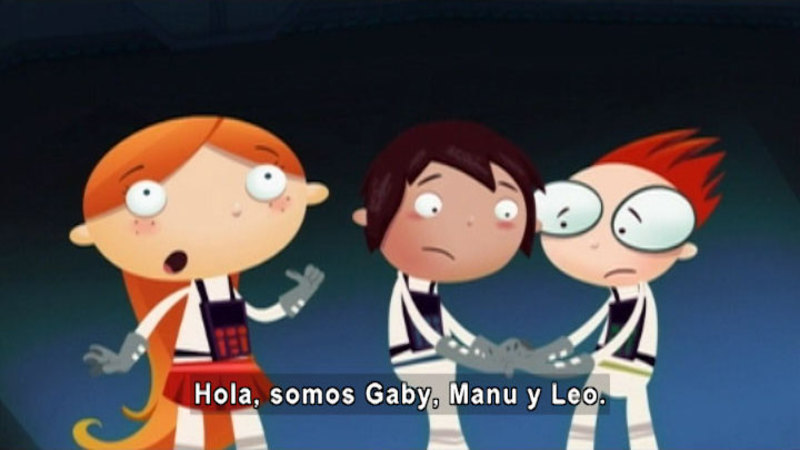<< Learning Center
Media Accessibility Information, Guidelines and Research
Spanish Language Resources from the DCMP

Welcome to the DCMP’s collection of Spanish language resources. Here, you can access DCMP articles that have been translated into Spanish, explore a F.A.Q. about accessibility (from dicapta), and find information about DCMP’s collection of Spanish language educational videos.
DCMP Learning Center Articles
The following articles from the DCMP Learning Center have been translated by the staff of dicapta.
Durante los Silencios (During the Quiet Parts)
Watching TV with their child who has a visual impairment, parents are accustomed to providing a few words of explanation during the quiet parts: what the laughter was about, a shift in plot when the narration is poor, or why the father on the sitcom was so upset about his daughter’s outfit, for example. Public school teachers have had to do the same regarding educational media used in the classroom. This article is a short message to parents about how the accessibility feature of description can fill in those quiet parts. Originally published in the National Association for Parents of Children with Visual Impairments (NAPVI) Awareness newsletter, the DCMP’s services to parents of or professionals working with children who are blind, visually impaired, or deaf-blind are highlighted.
Read Durante los Silencios
¿Como Hacer Para Que Mis Programas Sean Subtitulados? (How Do I Get My Media Captioned?)
Explains the difference between “open” and “closed” captioning, what questions need to be asked, what needs to be done after receiving the captioned product, and its benefits.
Read ¿Como Hacer Para Que Mis Programas Sean Subtitulados?
Read English version of “How Do I Get My Media Captioned?”
Haga Sus Producciones Mas Accesibles (Making Your Productions Accessible)
Why should you make your media accessible? Why should you caption and describe your productions? Not only is it the right thing to do, but marketing opportunities exist for media companies based on the needs of the following groups: persons with a hearing loss, persons with a vision loss, the ESL population, senior citizens, persons with literacy problems, and persons in the global market. The result of captioning and describing your media items will most likely prove beneficial and rewarding.
Read Haga Sus Producciones Mas Accesibles
Read English version of “Making Your Productions Accessible: How Captioning and Description Can Benefit You”
¿Que es la Descripcion? (What is Description?)
Description enables those who are blind or visually impaired to have full access to media materials that otherwise would not be readily available. Thomas Lohman, DCMP communications services specialist, helps answer many questions that consumers sometimes have, such as the following: What is description? How is description accessed? What is description’s role in education?
Read ¿Que es la Descripcion?
Accessibility F.A.Q.
The following F.A.Q. is provided by dicapta.
¿Qué es Caption?
Caption (texto escondido) es una tecnología que permite convertir la información sonora de un programa de televisión en un recuadro con texto, facilitando así al televidente con discapacidad auditiva el acceso a la información sonora.
Este texto puede ser presentado de dos formas: la primera es visible para el televidente todo el tiempo y se conoce como Open Caption; la segunda es activada por el televidente desde el control remoto del televisor o para el caso de la televisión digital, desde el control de la caja decodificadora (STB), y se llama Closed Caption (CC).
La inserción del captions a un programa de televisión es realizada manualmente por operadores especializados, con la ayuda de programas de computador y equipos diseñados para este propósito.
¿Qué es Descripción de Video?
Dicapta es la empresa pionera en realización de descripciones de video en español. La descripción de video es una narración verbal de los principales elementos visuales del programa con el propósito de brindar accesibilidad a las personas con limitaciones visuales a programas de televisión, películas, videos o cualquier otro tipo de producción audiovisual, para que su comunicación tenga todo el sentido.
En el caso de programas de televisión, esta narración está disponible en un canal de audio alterno, que debe ser activado por la persona interesada en escucharlo.
Spanish Language Media Available from the DCMP
To search only for DCMP's Spanish-language videos, set your browsing preferences to "Spanish Captioned" or "Spanish Described." Learn more in our Help Center under How to Locate Media.
Tags:
Please take a moment to rate this Learning Center resource by answering three short questions.
